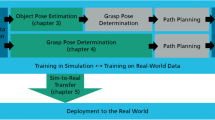Abstract
Autonomous mobile robots form an important research topic in the field of robotics due to their near-term applicability in the real world as domestic service robots. These robots must be designed in an efficient way using training sequences. They need to be aware of their position in the environment and also need to create models of it for deliberative planning. These tasks have to be performed using a limited number of sensors with low accuracy, as well as with a restricted amount of computational power. In this contribution we show that the recently emerged paradigm of Reservoir Computing (RC) is very well suited to solve all of the above mentioned problems, namely learning by example, robot localization, map and path generation. Reservoir Computing is a technique which enables a system to learn any time-invariant filter of the input by training a simple linear regressor that acts on the states of a high-dimensional but random dynamic system excited by the inputs. In addition, RC is a simple technique featuring ease of training, and low computational and memory demands.
Similar content being viewed by others
References
Antonelo EA, Baerlvedt A-J, Rognvaldsson T, Figueiredo M (2006) Modular neural network and classical reinforcement learning for autonomous robot navigation: inhibiting undesirable behaviors. In: Proceedings of IJCNN 2006, Vancouver, Canada
Antonelo EA, Schrauwen B, Dutoit X, Stroobandt D and Nuttin M (2007). Event detection and localization in mobile robot navigation using reservoir computing. In: (eds) ICANN, Part II, pp 660–669. Springer-Verlag, Berlin
Arleo A, Smeraldi F and Gerstner W (2004). Cognitive navigation based on nonuniform gabor space sampling, unsupervised growing networks, and reinforcement learning. IEEE Trans NN 15(3): 639–652
Bailey T, Durrant-Whyte H (2006) Simultaneous localisation and mapping (SLAM): Part ii state of the art. Rob Autom Mag September 2006
Forster A, Graves A, Schmidhuber J (2007) RNN-based learning of compact maps for efficient robot localization. In Proceedings of ESANN
Jaeger H (2001) Short term memory in echo state networks. Technical Report GMD Report 152, German National Research Center for Information Technology
Jaeger H (2002) Tutorial on training recurrent neural networks, covering bptt, rtrl, ekf and the “echo state network” approach. Technical Report GMD Report 159, German National Research Center for Information Technology
Jaeger H and Haas H (2004). Harnessing nonlinearity: predicting chaotic systems and saving energy in wireless telecommunication. Science 308: 78–80
Jaeger H, Lukosevicius M and Popovici D (2007). Optimization and applications of echo state networks with leaky integrator neurons. Neural Netw 20: 335–352
Krose BJA, Eecen M (1994) A self-organizing representation of sensor space for mobile robot navigation. In: Proc. of the IEEE int. conf. on intelligent robots and systems, September 1994
Maass W, Natschläger T and Markram H (2002). Real-time computing without stable states: a new framework for neural computation based on perturbations. Neural Comput 14(11): 2531–2560
Maass W, Joshi P, Sontag E (2006) Principles of real-time computing with feedback applied to cortical microcircuit models. In: Weiss Y, Schölkoff B, Platt J (eds) Advances in neural information processing systems, vol 18. MIT Press, Cambridge
Najand S, Lo Z, Bavarian B (1992) Applications of self-organizing neural networks for mobile robot environment learning. In: Bekey GA, Goldberg KY (eds), Neural networks in robotics. Kluwer Academic Publishers, pp 85–96
Nikolić D, Häusler S, Singer W, Maass W (2007) Temporal dynamics of information content carried by neurons in the primary visual cortex. In: Advances in neural information processing systems 19, vol 19
Rylatt RM and Czarnecki CA (2000). Embedding connectionist autonomous agents in time: the ‘road sign problem’. Neural Proc Lett 12: 145–158
Schrauwen B, D’Haene M, Verstraeten D, Van Campenhout J (2007) Compact hardware for real-time speech recognition using a liquid state machine. In: Proceedings of the IJCNN
Schrauwen B, Verstraeten D, Van Campenhout J (2007) An overview of reservoir computing: theory, applications and implementations. In: Proceedings of the European symposium on artifical neural networks (ESANN)
Steil JJ (2004) Backpropagation-decorrelation: online recurrent learning with O(N) complexity. In: Proceedings of IJCNN ’04, vol 1, pp 843–848
Thrun S (1998). Learning maps for indoor mobile robot navigation. Artif Intell 99: 21–71
Verstraeten D, Schrauwen B, D’Haene M and Stroobandt D (2007). A unifying comparison of reservoir computing methods. Neural Netw 20: 391–403
Yamazaki T and Tanaka S (2007). The cerebellum as a liquid state machine. Neural Netw 20: 290–297
Author information
Authors and Affiliations
Corresponding author
Rights and permissions
About this article
Cite this article
Antonelo, E.A., Schrauwen, B. & Van Campenhout, J. Generative Modeling of Autonomous Robots and their Environments using Reservoir Computing. Neural Process Lett 26, 233–249 (2007). https://doi.org/10.1007/s11063-007-9054-9
Received:
Accepted:
Published:
Issue Date:
DOI: https://doi.org/10.1007/s11063-007-9054-9




